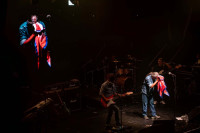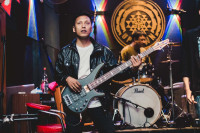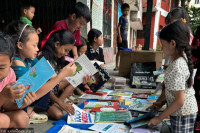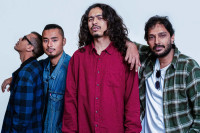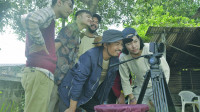Entertainment
Rebuilding Recaptured
May 10 saw the launch of a one of a kind, community art project by Lasanaa/NexUs of Nepal in association with the University of the Arts in Helsinki.
Kurchi Dasgupta
May 10 saw the launch of a one of a kind, community art project by Lasanaa/NexUs of Nepal in association with the University of the Arts in Helsinki. It brought together artists, writers and researchers from Nepal, Bangladesh, Finland and India to continue the healing process among the residents of Sipapokhari village of Sindhupalchowk that lay near the epicenter of the 2015 earthquakes.
Initiated by Ashmina Ranjit, one of Nepal’s foremost contemporary art practitioners, the five week-long residency enriched not only the participants but left behind seeds for future community development. The eighteen artists, including ten from Nepal and five from Finland, worked closely among themselves and with the local community to create a body of work that will be showcased in Kathmandu in August and later in Sipapokhari itself.
The project began with ten days of cultural immersion and introductions for the visitors and locals, during which the visitors picked up on the many cultural nuances of a Nepali way of life in urban Kathmandu. Preliminary workshops, both in writing and art, were held to enhance skills that would later come in handy when interacting with Sipapokhari resients. For example, Columbia University trained writer Muna Gurung of Nepal led a writing workshop, while Kala Bhavana trained visual artist Amritah Sen of India led a bookmaking one.
Once they reached Sipapokhari, the group spread out among six Dalit homes and took up residence. The focus of Rebuilding Recaptured was the marginalised community, particularly the Dalits and the Tamangs. By physically inhabiting their space and sharing their food, the international group broke through time worn barriers and customs that restrict and humiliate the marginalised.
The local participation was four-tiered: children, adolescents, mothers and teachers. Ten children and adolescents from marginalised communities, studying in different schools, participated in creative writing and artmaking workshops and eagerly took in the many ideas and possibilities that the visitors brought in. Some of the children had already taken part in a photography workshop organised earlier in the year, and had even visited Kathmandu to attend the Kathmandu Triennale. Their experiences and artistic and writing skills were brought together in the form of individual project submissions. In future, this is about to reach a larger readership as a children’s storybook Diya and the Guava Tree that will open a rare window into the lives of the rural and marginalised community of Nepal. The mothers’ group interacted with the artists and participated in similar expressive activities, and produced some remarkable artworks. The teachers, mostly from more privileged backgrounds, participated with equal enthusiasm. Amritah Sen says, “The teachers of four different schools of Sipapokhri village participated in a book art workshop with us where we encouraged them to document their own history by mapping the village from different angles. I was pleasantly surprised to see this enthusiastic group of teachers—both male and female—who worked as teams with their students, reacted positively to every suggestion given to them and finally came up with neatly drawn, coloured and labelled maps of various kinds of their village. One group made a particularly fascinating map, pointing out all the things they want to see in the village happening in next five years. They readily agreed upon the importance of documentation of local and small history.” Documentation, along with creative expression, was a prime thrust of the residency. A research project initiated by JP Kaljonen of Finland and Abu Naser Robi of Bangladesh introduced students of local schools, both in Sipapokhari and Bungamati, to the workings and merits of research and analytical tools like surveys.
Coming to the artists, an initial open day at NexUs held about a week ago showcased an array of exciting artworks. On the roof stood a musical instrument conceptualised by artist Yajyu Manandhar in collaboration with the children and later realised here from metal scraps. Crafted out of metal tubes and discarded grill gates, it replicates the music the children created everyday from almost nothing in Sipapokhari, even as they played among themselves. Sound was central to many of the artworks: a haunting soundscape that slipped between the environmental, daily ‘noise’ of everyday Sipapokhari to well structured arias extracted from found objects; or a dry water tap emitting the gurgle of rushing water that not only comments on the scarcity of potable water here in the Valley, but also had, en site in Sindhupalchowk, presented a sharp critique of the sluggish Melamchi project. A collaborative, interactive installation created from discarded clothes and fabrics was set in motion by Ashmina Ranjit herself, to be completed by the time the final exhibition happens in August. It hopes to explore and perform the notions of communication and harmony vs miscommunication and disharmony or chaos.
The final exhibition promises to be quite a treat with artworks and projects by Sipapokhari’s children and adolescents on show, along with artbooks, videos, photographs, musical instruments and installations, soundscapes, paintings. Blow-ups of the imagined maps and the storybook will be taken back to the original site of the residency too. What I found particularly interesting about the residency was its commitment towards giving back to the community through tangible but short lived as well as intangible but long lasting materials and processes. Meanwhile, the artists themselves were able to do some serious research and conceptualising, even as the period of stay turned into a piece of artwork itself, since the visiting participants encountered and negotiated many socio-political obstacles and hiccups while remaining focused on broadening the channels of reciprocal communication. A step in the right direction, no doubt!




 24.12°C Kathmandu
24.12°C Kathmandu
